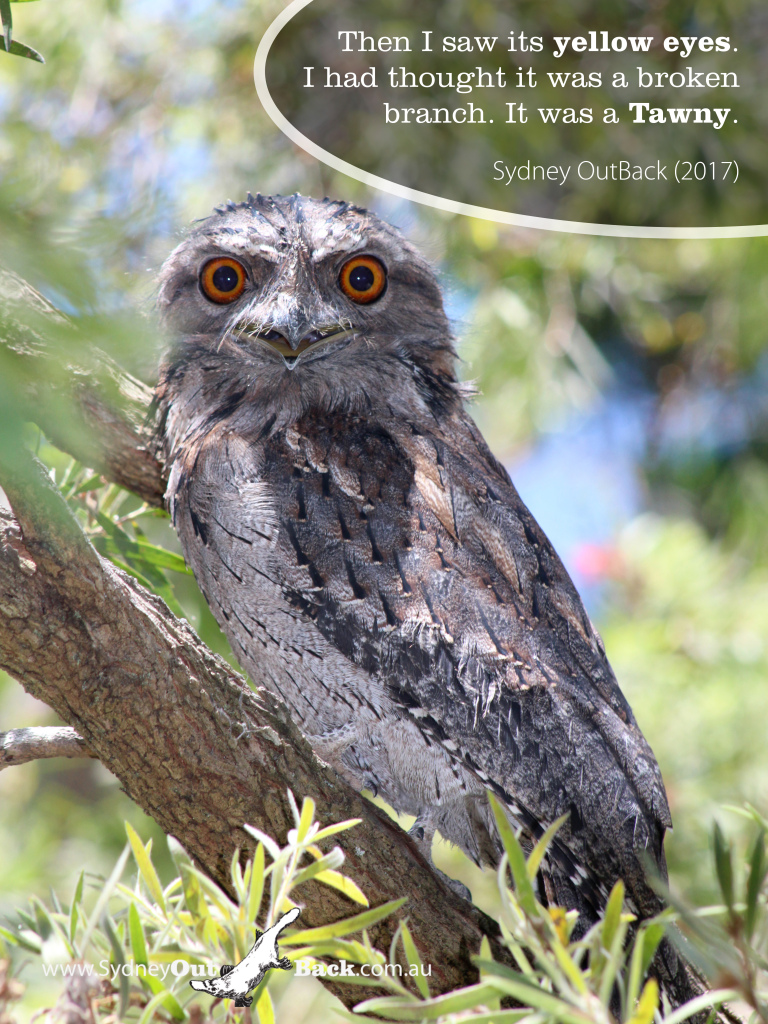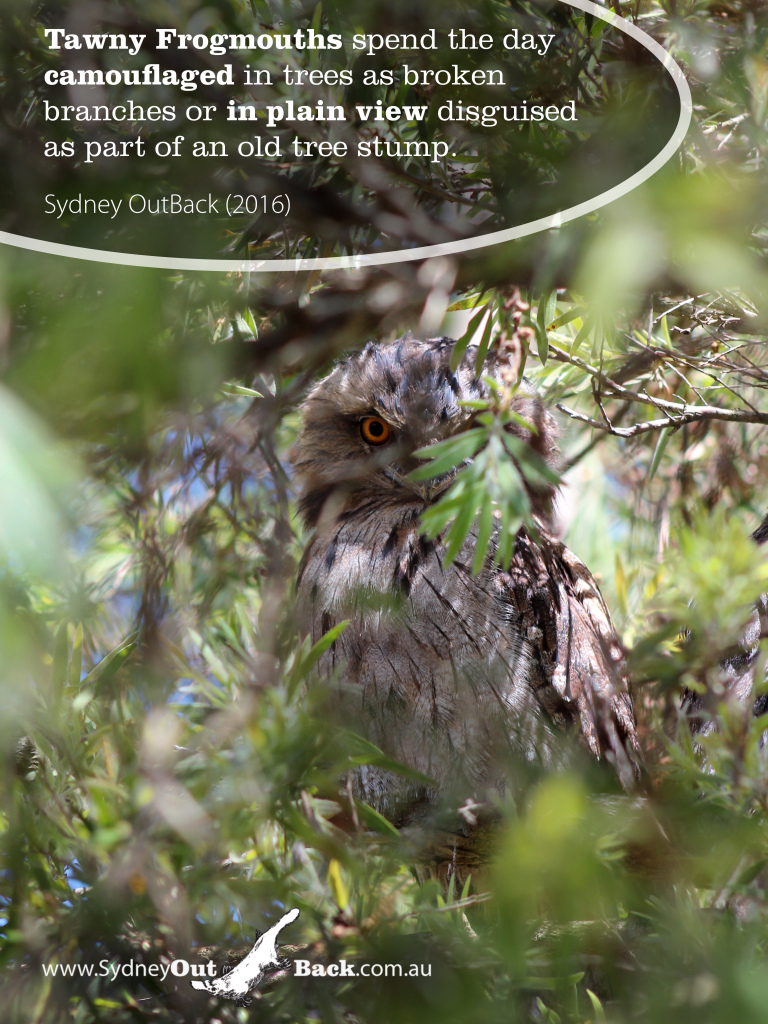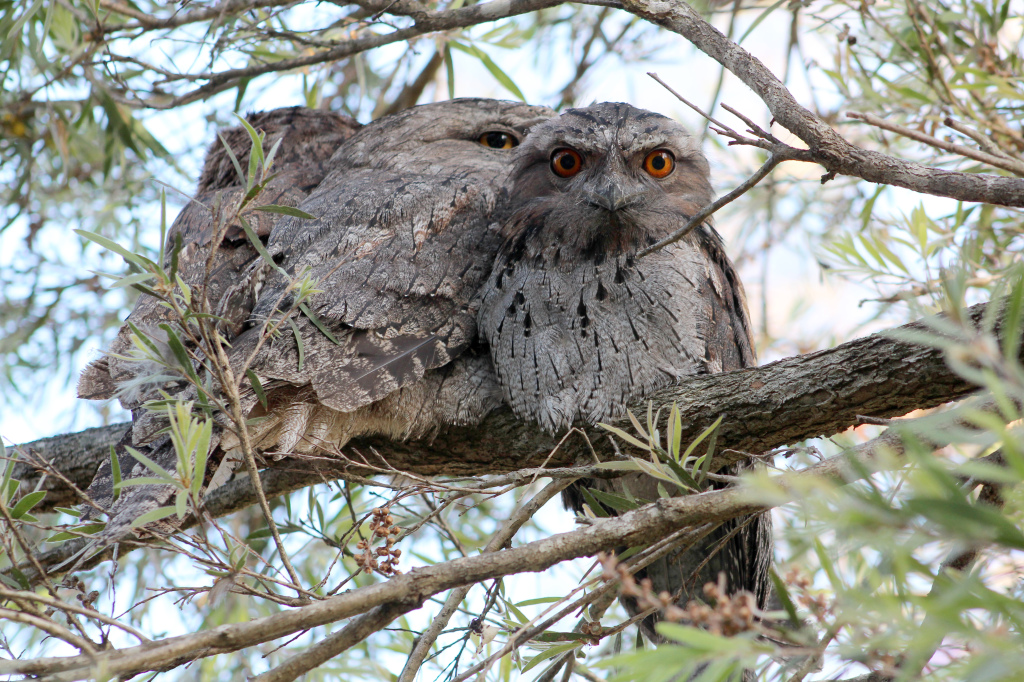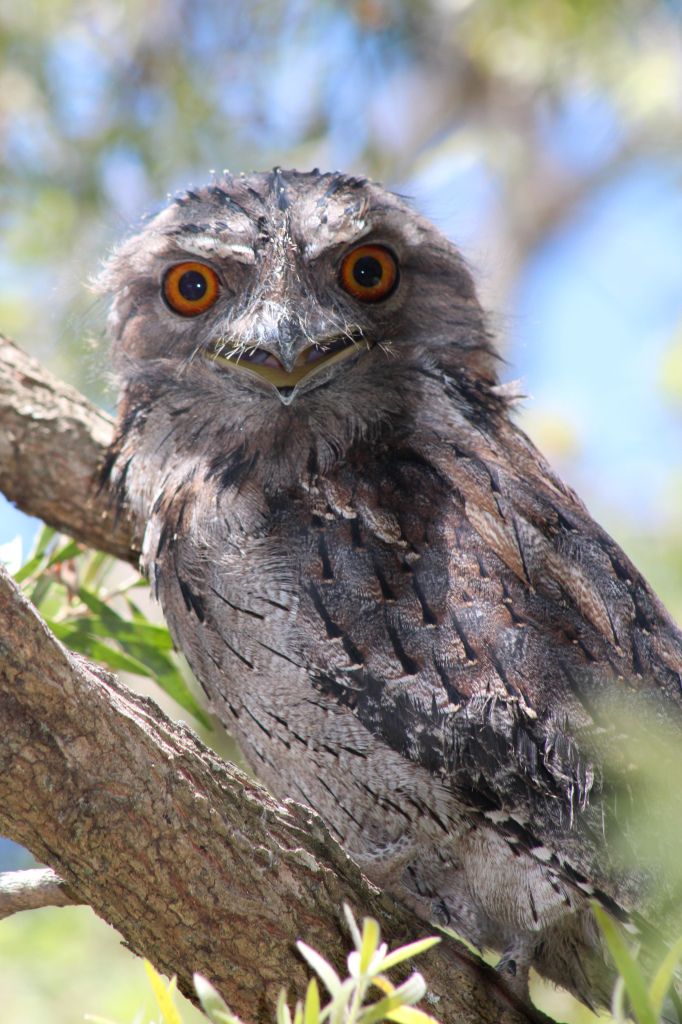When is an owl not an owl? When it’s a Tawny.
by
SydneyOutBack.com.au :
January 15th, 2017
 Sydney OutBack monitored a local Tawny Frogmouth family this summer, getting to know a new generation of the common Aussie nocturnal hunter over several daytime encounters – all under the watchful gaze of their round, piercing yellow eyes!
Sydney OutBack monitored a local Tawny Frogmouth family this summer, getting to know a new generation of the common Aussie nocturnal hunter over several daytime encounters – all under the watchful gaze of their round, piercing yellow eyes!
Test how much you know about the Tawny Frogmouth, Podargus strigoides, against Sydney OutBack’s Top 7 “True or False” facts:
- The Tawny Frogmouth is a common night owl in Australia.False! The Tawny Frogmouth isn’t actually an owl, it’s a night-jay or nighthawk (one of three types of its kind in the world). Its nocturnal hunting and carnivorous diet contributed to a mislabeling as an owl.
- The Tawny Frogmouth got its name from a strict diet of frogs.False. While Tawnys do eat frogs, their prey includes small mammals and reptiles (ie. mice, lizards), insects, worms and slugs, fish, amphibians and crustaceans. Surprisingly, on its disproportionately larger head is a distinctive, almost frog-like, bill that is hooked and angular ideal for catching its smaller wiggly prey. If seen with its bright yellow mouth open, it’s either panting in the heat or warning off a perceived risk or predator.
- Tawny Frogmouths are poor flyers because their body is too heavy.False. While not a great flyer, the Tawny is very purposeful in its design! The carnivore is described as a sit-and-wait hunter and they spend their lives in the same territory, so long flights are unnecessary. Instead, their wings are constructed for and conducive to stealth and silence as it swoops upon prey, snatching it from the ground or mid-flight. If alarmed, Tawnys respond swiftly to fly to safety.

- Tawnys camouflage as trees during the day.True. With plumage that is ash-grey to brown (with silvery hues and dark lines along the dorsal side that resembles the shadow and light in tree bark), Tawny Frogmouths spend the day camouflaged in trees as broken branches or in plain view disguised as part of an old tree stump (adults range form 30 -50cm in length). When not sleeping, Tawnys spy and survey with bright, piercing yellow eyes that make you feel like you’re being watched in the bush!
- Tawny Frogmouths are a threatened species in rural and urban habitats.False. Tawnys have robust populations across Australia, except in dense rainforest and treeless deserts. They are not on the threatened or endangered species lists, despite its three main predators being introduced and aggressive hunters (the feral/domestic cat, dogs and foxes). The biggest threat to Tawnys is an encounter with a car, which rarely ends in its favour.
- Tawnys are solitary birds.False. While Tawnys hunt alone, they pair for life and share life’s labours: constructing a nest from sticks, moss and lichen; sitting to incubate eggs; and feeding chicks to independence. They are occasionally seen perched in pairs during the day.

- Tawnys only breed after seasons of heavy rain, so may not breed for years in times of drought.False. While some truth lies in stronger breeding seasons after rain, an annual mating season spans August to December, when a deep, loud drumming noise is heard from the trees (that’s them). Between 1 – 3 eggs are laid and incubated for around 30 days, and chicks are nurtured in the nest for around the same period again before they learn to fly (at between 25 – 35 days old). The average lifespan is 5-7 years, and up to ten years in captivity.
 The especially secretive Tawny delights visitors on Sydney OutBack tours because no one seems to know who is watching whom – and everyone feels like someone has been watching! This uncomfortable sense of exposure also had an impression on generations of Aboriginal people, with some believing the bird could literally turn to wood and others identifying their call as a bad omen (one example, from WA, can be read here). To learn more about Sydney OutBack’s Wilderness and Aboriginal Explorer Tour and Cruise, just click here.
The especially secretive Tawny delights visitors on Sydney OutBack tours because no one seems to know who is watching whom – and everyone feels like someone has been watching! This uncomfortable sense of exposure also had an impression on generations of Aboriginal people, with some believing the bird could literally turn to wood and others identifying their call as a bad omen (one example, from WA, can be read here). To learn more about Sydney OutBack’s Wilderness and Aboriginal Explorer Tour and Cruise, just click here.
Our tours are also part of Tourism Australia’s Indigenous Tourism Champions Program (ITCP), recognizing that we offer a quality experience that that meets the needs and expectations of international visitors.
0 Flares
0
Facebook
0
Google+
0
LinkedIn
0
0 Flares
×

 Sydney OutBack monitored a local Tawny Frogmouth family this summer, getting to know a new generation of the common Aussie nocturnal hunter over several daytime encounters – all under the watchful gaze of their round, piercing yellow eyes!
Sydney OutBack monitored a local Tawny Frogmouth family this summer, getting to know a new generation of the common Aussie nocturnal hunter over several daytime encounters – all under the watchful gaze of their round, piercing yellow eyes!

 The especially secretive Tawny delights visitors on Sydney OutBack tours because no one seems to know who is watching whom – and everyone feels like someone has been watching! This uncomfortable sense of exposure also had an impression on generations of Aboriginal people, with some believing the bird could literally turn to wood and others identifying their call as a bad omen (one example, from WA, can be read here). To learn more about Sydney OutBack’s Wilderness and Aboriginal Explorer Tour and Cruise, just click here.
The especially secretive Tawny delights visitors on Sydney OutBack tours because no one seems to know who is watching whom – and everyone feels like someone has been watching! This uncomfortable sense of exposure also had an impression on generations of Aboriginal people, with some believing the bird could literally turn to wood and others identifying their call as a bad omen (one example, from WA, can be read here). To learn more about Sydney OutBack’s Wilderness and Aboriginal Explorer Tour and Cruise, just click here.